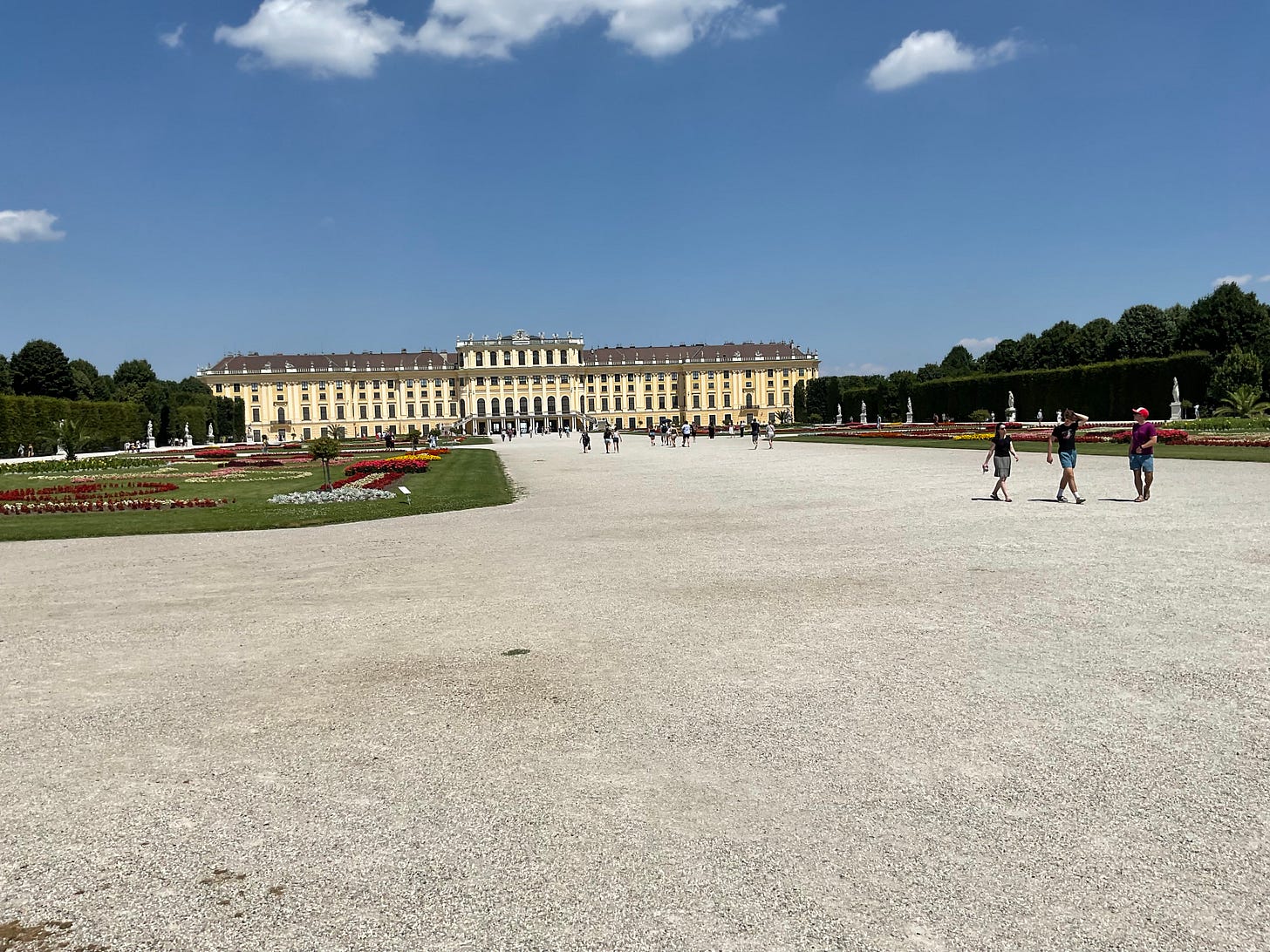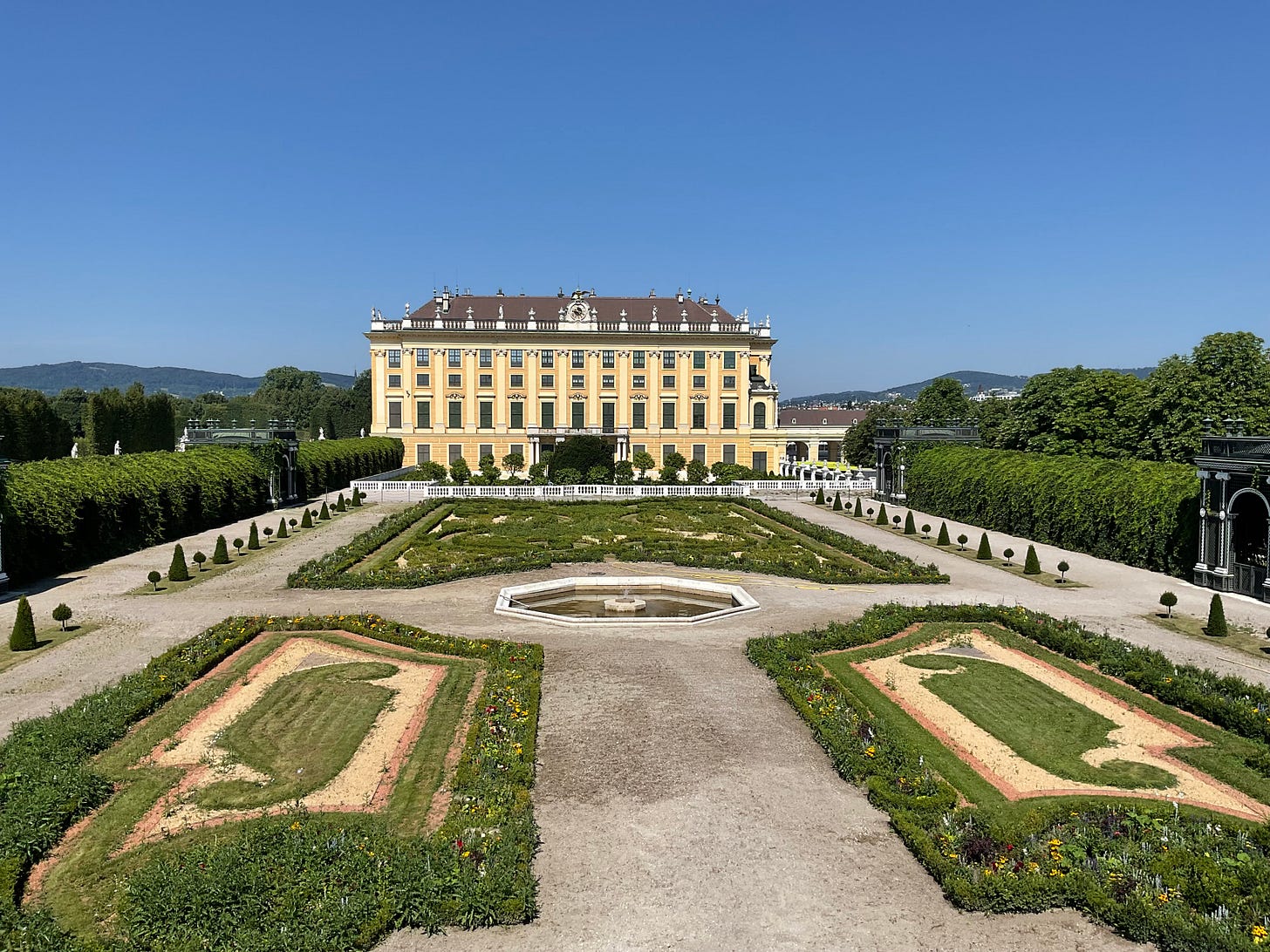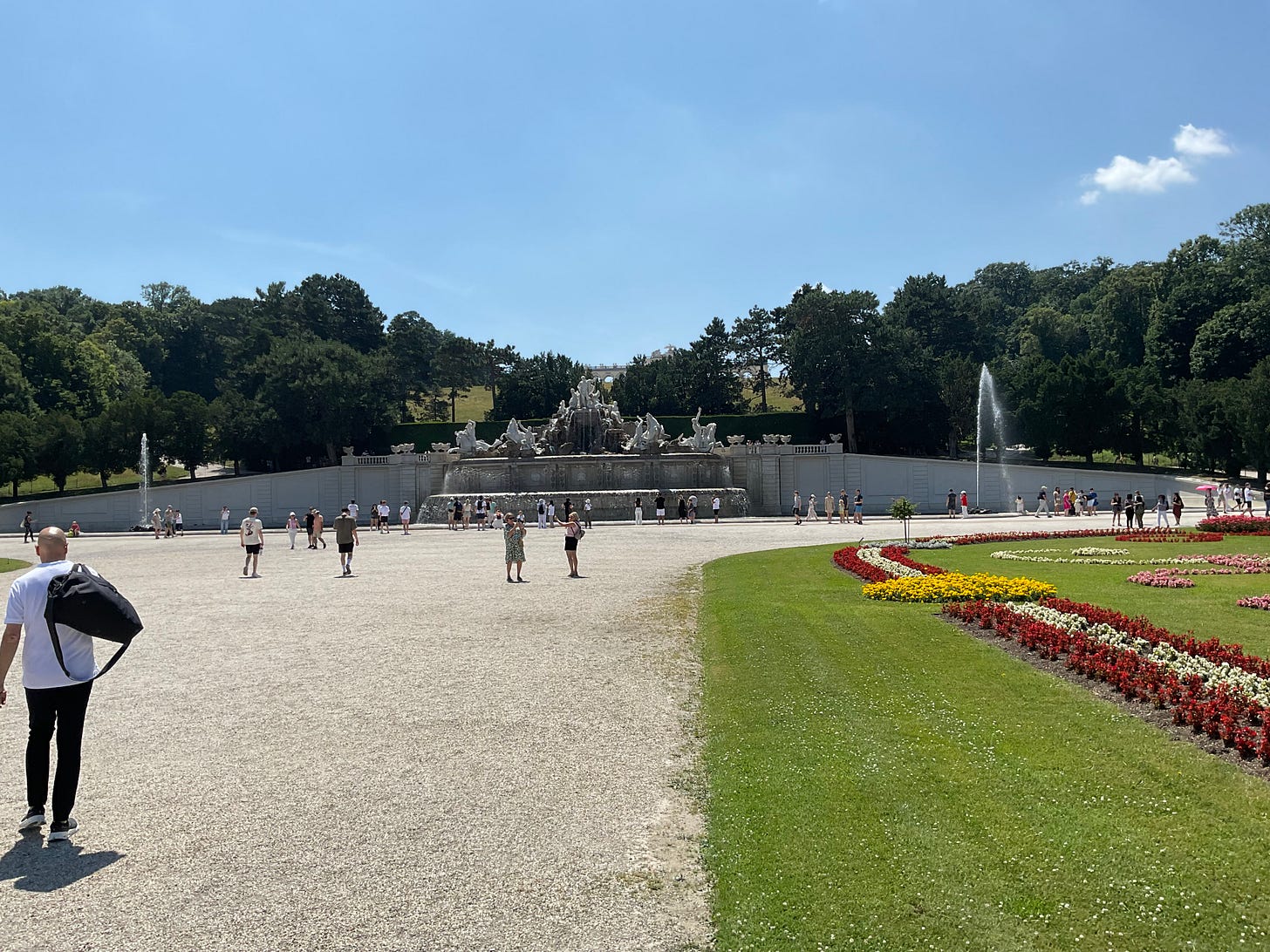Travel Diary 2: Vienna
An imperial city.
Vienna is an imperial city that from the C17th onwards, largely obliterated its medieval past. Walking around, it seems a flat city until suddenly you are walking across a city-scape canyon that seemed to be traces of the old medieval walls. Eagles, imperial insignia and heraldry are recurring architectural motifs.
We stayed at the Benediktushaus, a former monastery in the middle of the city, which also provided a fine, serve yourself, breakfast. I don’t normally eat breakfast, but I have found having a light, mostly carnivorous “ketovore” breakfast enables me to get through active days of walking with just a one meal in the evening.
Vienna is a larger city than Prague, but you can still cover quite a range of sites by walking. Moreover, it has excellent public transport: subway, trams, buses. Along with the open-air vintage style cars and horse-drawn carriages one also saw in Prague, I was amused by what I thought of as “Viennese rickshaws”—two-passenger vehicles driven by driver-pedal power.
Thursday night, found essentially a burger joint that did a tasting rack of beer. I had the pulled beef, with tasting rack. The beers were pleasant, but unremarkable. The pulled beef was very tasty.
Friday, took ourselves out to the Belvedere, the Austrian Blenheim Palace, though with a much happier history: the palace built for the one military genius to ever serve the House of Habsburg, Prince Eugene of Savoy. Belvedere was not religious, pagan or national in its aesthetic statement, it very much displayed the personal taste of Prince Eugene.
Some of the exibits within the Palace had slightly annoyingly fashionable comments. On the other hand, there were a considerable amount of medieval art, well worth the visit, even apart from the fine architecture and lovely gardens.
The cafe at the Lower Belvedere managed the best coffee since Melbourne. Nigel felt compelled to have the Mozart cake, which was flavoursome, moist and not too sweet. (Due to my gluten intolerance, I only had a small piece of Nigel’s cake.)
Friday night, took ourselves down to the river, where we discovered where the graffiti absent from the rest of the city was. The dystopian industrial look of the river bank, despite clearly being a popular walking and dining strip, did not attract.
We walked around the commercial district. I spotted, in a shop that was, alas, closed, a t-shirt that said “No kangaroos in Austria”: I managed to buy one a few days later. We ended up having a rather inferior paella—you can get much better paella in Melbourne.
Saturday, trained and trammed out to Schonbrunn Palace, the Austrian Versailles. The upper floor rooms were light and airy, done in a restrained opulence. Many of the lower floor rooms were quite oppressive in style. The Chinese room was typically hideous, as such rooms tend to be. Nigel, my business partner, tells me that Schronbrunn is not as pompous as Versailles. It is also clearly designed to be more practical.
The gardens are very extensive and open to the public. Various attractions within the gardens, and the Palace itself, require a ticket. It is definitely a good idea to get there early, as the crowds get more extensive as the day goes on. The longest delay for us was putting in, and later retrieving, our shoulder bags, which were not allowed in the Palace.
The Orangerie was lovely. We were there on a particularly hot day, over 30o, which had the value of bringing out how well designed to moderate heat various parts of the gardens were, including the Orangerie itself. Its heating system is based on Roman hypocaust designs, which Europe could replicated by the C18th. (Nigel pointed out that the Romans lost some technical abilities before the collapse of the Western Empire.)
The private garden of the imperial family was a nice example of how an attractive private space can be created in such a large complex.
The Gardens include a labyrnith—that is, a collection of mazes. Nigel loves mazes so we walked around the difficult one, with the hedges too high to look over. I rested while he walked through one of the simpler ones and the hard one again.
I do recommend just sitting at various points in the gardens and enjoying the ambiance. I took myself up the hill to the Gloriette, a neoclassical construction at the top of the grounds which gave the Palace something to look at and a picnic spot with a fine view. About half way up, there is a truly spectacular fountain.
The Gloriette now contains a cafe, that you enter from the back. The roof of the cafe was a joy in itself, Habsburg imperial finery done in cream sculptures and finishes on a tan (coffee) background. Despite the heat, I had a hot chocolate with orange liquer. After Nigel arrived, I had a peach melba (a desert, not the drink). Nigel had a spritz and a mango torte. When we finished, the lovely waiter apologised for heat. I told him we were Australians, and used to it.
The walk down was much easier than up. Fortunately, the side paths are well shaded. It is fun to stand just behind the fountain. We trammed back to the city centre.
Saturday night, had a lovely meal at Cantinetta Allora, on the Universitatsring. I had a Surf & Turf, exquisitely cooked prawns with melt-in-your-mouth beef, a green pepper sauce and rosemary potatoes. With a lovely white wine before the meal arrived and an excellent red wine with it, both chosen by the waiter.
Sunday was also very hot, so we took ourselves to the Heeresgeshicte Museum, at the Arsenal. It is the oldest museum in Vienna, created to celebrate the military history of the Habsburgs and provide barracks and training grounds for Habsburg troops.
The military successes of Habsburg arms during the 1848-9 Revolutions and nationalist uprisings was covered in some detail. A well-drilled and well-led army made of conscripts from landed peasantries proved well able to defeat urban revolutionaries in Vienna, liberal nationalist nobles and intelligentsia in Italy and (with Russian help) similar in Hungary.
The museum is an engaging mix of old style museum with more immersive modern presentations. The Great War exhibition was grim, informative and well-done. There are some fabulous models in the Naval Museum wing. While the Danbuian Monarchy entered the Great War with inferior artillery and outdated cavalry tactics, it managed to be innovative in military use of air power and a more than competent producer of warships. As with the Prague Army Museum, the history was presented clearly, factually and well.
In the cafe-restaurant in the park on the way back, discovered Schremser Doppelmalz, a dark beer I very much enjoyed. That night, had a lovely Japanese meal at Mikata Izakawai. The service was very friendly, and the food fabulous. I have a particular weakness for grilled eel, while powdered matcha adds a rather pleasant complexity to melted chocolate in chocolate fondant.
Things are often closed on a Monday in Vienna: both the Imperial Armoury and the Votive Church were closed. The Crown Jewels display was, however, open and a fabulous visit. Not merely for the various crowns and regalia, but also the very impressive sets of heraldric tabards. I was particularly impressed with those from the C15th Duchy of Burgundy. (Maximillian marrying Mary of Burgundy was a key step in the expansion of Habsburg power.)

Monday night, I had a lovely mixed grill in a restaurant in a garden courtyard, Nigel had an excellent trout. The Austrian brown ale was particularly good.
Tuesday, we took ourselves, by train and bus to Carnuntum, which was a major Roman legionary fort and city. The complex included the governor’s residence. A complex that may have had 50,000 residents at its height.
Marcus Aurelius wrote the second book of his Meditations at Carnuntum. Septimius Severus was the local governor when his troops proclaimed him Emperor, leading to the founding of the Severan dynasty. A conference was held there in 308 to attempt—ultimately unsuccessfully—to stabilise the Tetrarchy.
This Roman city and legionary fort has become the basis for an excellent range of experiences, from observing the results of archaeology, a large model of the complexes, rebuilt buildings one can move around in, and re-creative films. You can also walk to the remains of the local amphitheatre, used for a mixture of gladiatorial games and military display and drill. Though the re-created gladitorial training complex has not been maintained, and is now off-limits.
Bused and trained back to Vienna. That night, had another lovely meal at Mikata Izakawai, because it was nearby and we had enjoyed the previous meal there so much.
Wednesday, we trained to Budapest.
We very much enjoyed Vienna, though the level of pollution was not good for Nigel’s lungs. Dining al fresco was also sometimes marred by the number of smokers.
Vienna seemed very relaxed about its history, neither conflicted nor nostalgic. It was just was what it was. Like Prague, I found the architecture relaxing in itself. Pleasing to look at, human in scale, integrating both classical and Christian heritage. Being able to just walk around and get a feel for city was enjoyable in itself.












You are my kind of travel writer. “I went here, saw this excellent historical thing, this excellent building and then I ate this.” ALL THE IMPORTANT THINGS.
Gorgeous article, gorgeous city! Any chance you will make it to Budapest? (sent you a DM)